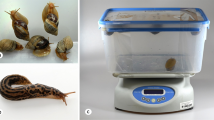Summary
The development of the lesions caused by Argas persicus larvae while feeding on chickens, their natural hosts, was followed using histological techniques.
Penetration of the skin by the mouthparts was accompanied by rapid lysis of the cells of the epidermis and dermis within 100 μm of the mouthparts. A foreign-body reaction developed within 2 mm of the attachment and was characterized by rapid dilation of blood vessels, emigration of leucocytes, particularly heterophil leucocytes (heterophils) into the tissues and oedema. Haemorrhage developed near to the mouthparts and within 2 h of the start of feeding, erythrocytes were seen in the gut caeca of the larvae. Whole blood provides the diet of the larva throughout the entire period of feeding and unlike the situation described with nymphal and adult A. persicus the blood is lysed immediately after ingestion.
By 30 h the extra-vascular heterophils had migrated to the mouthparts around which they formed a loose, superficial, collar. Further emigration of heterophils into the tissues then ceased, although some were present in the blood being ingested. It appears that the heterophils mask the mouthparts so that they are no longer recognised as foreign by the host and thus provide an example of the concept of adaptation tolerance. But the development of lymphocyte and monocyte infiltrations in the dermis close to the mouthparts indicates that the immunological response of the host to salivary secretions is not suppressed.
Oedema which develops around the site of attachment further protects the larvae from the host's predations.
Similar content being viewed by others
References
Arthur, D. R.: Ticks and Disease. London: Pergamon Press 1962
Cowdry, E. V.: Studies on the etiology of heartwater. II. Rickettsia ruminantium (n. sp.) in the tissues of ticks transmitting the disease. J. exp. Med. 42, 253–274 (1925)
Gregson, J. D.: Observations on the movement of fluids in the vicinity of the mouthparts of naturally feeding Dermacentor andersoni Stiles. Parasitology 57, 1–8 (1967)
Gregson, J. D.: Electrical observations of tick feeding in relation to disease transmission. Proc. 2nd Intl. Congr. Acarol. 1967. 329–339 (1969)
Lavoipierre, M. M. J., Riek, R. F.: Further studies on the reactions of the skin of laboratory animals to the bites of argasid ticks. Trans. roy. Soc. trop. Med. Hyg. 48, 285 (1954)
Lavoipierre, M. M. J., Riek, R. F.: Observations on the feeding habits of argasid ticks and on the effect of their bites on laboratory animals, together with a note on the production of coxal fluid by several of the species studied. Ann. trop. Med. Parasit. 49, 96–113 (1955)
Moorhouse, D. E.: The attachment of some ixodid ticks to their natural hosts. Proc. 2nd Intl. Congr. Acarol. 319–327 (1969)
Moorhouse, D. E., Tatchell, R. J.: The feeding processes of the cattle tick Boophilus microplus (Canestrini): a study in host-parasite relations. Part. I. Attachment to the host. Parasitology 56, 623–632 (1966)
Pearse, A. G. E.: Histochemistry: Theoretical and applied. 2nd ed. London: Churchill 1961
Smithers, S. R., Terry, R. J., Hockley, D. J.: Host antigens in Schistosomiasis. Proc. roy. Soc. B 171, 483–494 (1969)
Sprent, J. F. A.: Parasitism, Immunity and Evolution. In: The evolution of Living Organisms. (G. W. Leeper, ed.), p. 149–165. Melbourne: University Press 1962
Tatchell, R. J.: Digestion in the tick, Argas persicus, Oken. Parasitology 54, 423–440 (1964)
Tatchell, R. J.: Salivary secretion in the cattle tick as a means of water elimination. Nature (Lond.) 213, 940–941 (1967)
Tatchell, R. J., Moorhouse, D. E.: The feeding processes of the cattle tick Boophilus microplus. II. The sequence of host-tissue changes. Parasitology 58, 441–459 (1968)
Tatchell, R. J., Moorhouse, D. E.: Neutrophils: Their role in the formation of a tick feeding lesion. Science 167, 1002–1003 (1970)
Author information
Authors and Affiliations
Rights and permissions
About this article
Cite this article
Moorhouse, D.E. Studies on the feeding of larval Argas persicus Oken. Z. F. Parasitenkunde 48, 65–71 (1975). https://doi.org/10.1007/BF00389830
Received:
Issue Date:
DOI: https://doi.org/10.1007/BF00389830




